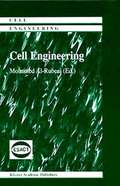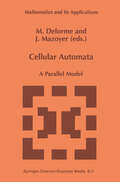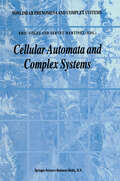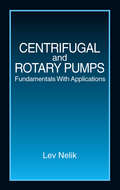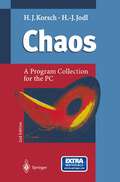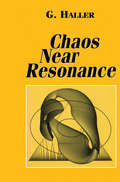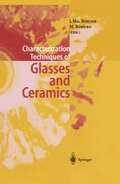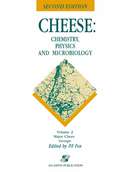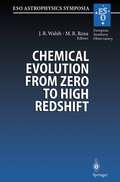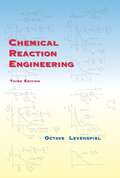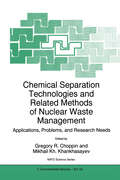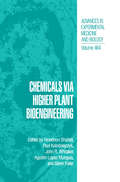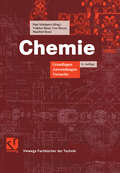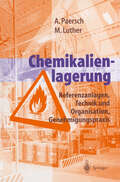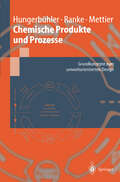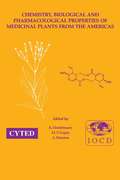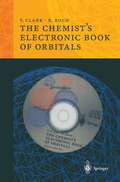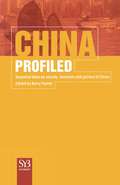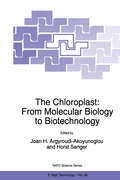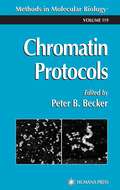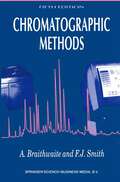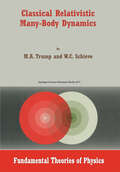- Table View
- List View
Cell Engineering (Cell Engineering #1)
by Mohamed Al-RubeaiIntegrating advances in molecular biology into bioprocesses presents a continuous challenge to scientists and bioengineers. This series is conceived to help meet this challenge. It examines and assesses the feasibility of new approaches for the modification of cellular function such as gene expression, protein processing, secretion, glycosylation, immortalisation, proliferation, and apoptosis as well as the systematic study of the metabolic genotype-phenotype relationship. The series provides detailed coverage of the methodology for improving cellular properties of cells used in the production of biopharmaceuticals, gene and cell therapies and tissue engineering. It also seeks to explain the cellular mechanisms underlying in vitro physiological activity and productivity. This volume, which is based on presentations at the `European Workshop on Animal Cell Engineering' held in Costa Brava, Spain, contains a collection of chapters relating to cellular function and modification by leading authorities in several different areas of basic research and the biopharmaceutical industry.
Cellular Automata: A Parallel Model (Mathematics and Its Applications #460)
by M. Delorme J MazoyerCellular automata can be viewed both as computational models and modelling systems of real processes. This volume emphasises the first aspect. In articles written by leading researchers, sophisticated massive parallel algorithms (firing squad, life, Fischer's primes recognition) are treated. Their computational power and the specific complexity classes they determine are surveyed, while some recent results in relation to chaos from a new dynamic systems point of view are also presented. Audience: This book will be of interest to specialists of theoretical computer science and the parallelism challenge.
Cellular Automata and Complex Systems (Nonlinear Phenomena and Complex Systems #3)
by E. Goles Servet MartínezThis book contains the courses given at the Fifth School on Complex Systems held at Santiago, Chile, from 9th .to 13th December 1996. At this school met researchers working on areas related with recent trends in Complex Systems, which include dynamical systems, cellular automata, symbolic dynamics, spatial systems, statistical physics and thermodynamics. Scientists working in these subjects come from several areas: pure and applied mathematics, physics, biology, computer science and electrical engineering. Each contribution is devoted to one of the above subjects. In most cases they are structured as surveys, presenting at the same time an original point of view about the topic and showing mostly new results. The paper of Bruno Durand presents the state of the art on the relationships between the notions of surjectivity, injectivity and reversibility in cellular automata when finite, infinite or periodic configurations are considered, also he discusses decidability problems related with the classification of cellular automata as well as global properties mentioned above. The paper of Eric Goles and Martin Matamala gives a uniform presentation of simulations of Turing machines by cellular automata. The main ingredient is the encoding function which must be fixed for all Turing machine. In this context known results are revised and new results are presented.
Centrifugal & Rotary Pumps: Fundamentals With Applications
by Lev NelikCentrifugal and Rotary Pumps offers both professionals and students a concise reference detailing the design, performance, and principles of operation of the different pumps types defined by the Hydraulic Institute. From historical background to the latest trends and technological developments, the author focuses on information with real-world prac
Chancen erneuerbarer Energieträger: Mögliche Beiträge und Beschäftigungseffekte
by Markus Mohr Arko Ziegelmann Hermann UngerDie Autoren betrachten in diesem Buch die Chancen erneuerbarer Energieträger auf dem Energiemarkt unter verschiedenen Aspekten. Anhand von Beispielen wird u.a. das Potential erneuerbarer Energieträger im Verbund mit der konventionellen Energieversorgung untersucht, es werden die damit verbundenen Kosten ausgewiesen sowie daraus resultierende Arbeitsmarkteffekte analysiert. In diesem Zusammenhang plädieren die Autoren für eine ausgewogenere volkswirtschaftliche Betrachtungsweise, die nicht nur die mit einem verstärkten Ausbau ressourcenschonender Energien verbundenen positiven Arbeitsmarkteffekte berücksichtigt, sondern die auch die unvermeidbaren Nachfragerückgänge in einzelnen Wirtschaftszweigen in die energiepolitische Diskussion mit einbezieht. Auf der Grundlage ihrer Studie geben die Autoren darüber hinaus Empfehlungen zum Ausbau erneuerbarer Energiesysteme, die an Entscheidungsträger aus Politik und Wirtschaft gerichtet sind.
Chaos: A Program Collection for the PC
by Hans Jürgen Korsch Hans-Jörg JodlChaos: A Program Collection for the PC presents an outstanding selection of executable programs with introductory texts to chaos theory and its simulation. Students in physics, mathematics, and engineering will find a thorough introduction to fundamentals and applications in this field. Many numerical experiments and suggestions for further studies help the reader to become familiar with this fascinating topic. The second edition includes one CD-ROM, the executable programs are Windows 95 compatible.
Chaos Near Resonance (Applied Mathematical Sciences #138)
by G. HallerA unified treatment of resonant problems with special emphasis on the recently discovered phenomenon of homoclinic jumping. After a survey of the necessary background, the book develops a general finite dimensional theory of homoclinic jumping, illustrating it with examples. The main mechanism of chaos near resonances is discussed in both the dissipative and the Hamiltonian context, incorporating previously unpublished new results on universal homoclinic bifurcations near resonances, as well as on multi-pulse Silnikov manifolds. The results are applied to a variety of different problems, which include applications from beam oscillations, surface wave dynamics, nonlinear optics, atmospheric science and fluid mechanics.
Characterization Techniques of Glasses and Ceramics
by Maximina Romero Jesus Ma RinconThis monograph stems from lectures given during the summer course at the University of La Laguna. It includes the main characterization techniques useful nowadays for ceramics, glasses and glass-ceramics, reviews the new microscopes for characterizing materials, and gives an overview of inorganic materials such as zeolites.
Cheese: Volume 2 Major Cheese Groups
by Patrick F. FoxThe first edition of this book was very well received by the various groups (lecturers, students, researchers and industrialists) interested in the scientific and techno logical aspects of cheese. The initial printing was sold out faster than anticipated and created an opportunity to revise and extend tht; baok. The second edition retains all 21 subjects from the first edition, generally revised by the same authors and in some cases expanded considerably. In addition, 10 new chapters have been added: Cheese: Methods of chemical analysis; Biochemistry of cheese ripening; Water activity and the composition of cheese; Growth and survival of pathogenic and other undesirable microorganisms in cheese; Mem brane processes in cheese technology, in Volume 1 and North-European varieties; Cheeses of the former USSR; Mozzarella and Pizza cheese; Acid-coagulated cheeses and Cheeses from sheep's and goats' milk in Volume 2. These new chapters were included mainly to fill perceived deficiencies in the first edition. The book provides an in-depth coverage of the principal scientific and techno logical aspects of cheese. While it is intended primarily for lecturers, senior students and researchers, production management and quality control personnel should find it to be a very valuable reference book. Although cheese production has become increasingly scientific in recent years, the quality of the final product is still not totally predictable. It is not claimed that this book will provide all the answers for the cheese scientist/technologist but it does provide the most com prehensive compendium of scientific knowledge on cheese available.
Chemical Evolution from Zero to High Redshift: Proceedings of the ESO Workshop Held at Garching, Germany, 14–16 October 1998 (ESO Astrophysics Symposia)
by Jeremy Walsh Michael R. RosaChemical Separation Technologies and Related Methods of Nuclear Waste Management: Applications, Problems, and Research Needs (NATO Science Partnership Subseries: 2 #53)
by Mikhail Kh. Khankhasayev Gregory R. ChoppinSeparation technologies are of crucial importance to the goal of significantly reducing the volume of high-level nuclear waste, thereby reducing the long-term health risks to mankind. International co-operation, including the sharing of concepts and methods, as well as technology transfer, is essential in accelerating research and development in the field. The writers of this book are all internationally recognised experts in the field of separation technology, well qualified to assess and criticize the current state of separation research as well as to identify future opportunities for the application of separation technologies to the solution of nuclear waste management problems. The major emphases in the book are research opportunities in the utilization of innovative and potentially more efficient and cost effective processes for waste processing/treatment, actinide speciation/separation methods, technological processing, and environmental restoration.
Chemicals via Higher Plant Bioengineering (Advances in Experimental Medicine and Biology #464)
by Fereidoon Shahidi Paul Kolodziejczyk John R. Whitaker Agustin Lopez Munguia Glenn FullerFood and raw material for its production was generally produced via the traditional agriculture. On the other hand, novel chemicals were manufactured in the laboratory or extracted from plant and animal sources. However, as the world population is steadily in creasing, there is a decrease in traditional agriculture productivity and concerns are also expressed over the damage inflicted to the environment and restrictions that might be en forced in food production. At the same time, there is an increasing demand for high qual ity agricultural products as well as for food ingredients related to both the traditional or newly discovered nutrients or phytochemicals. Trends and developments,~n the area of plant biotechnology and bioengineering has allowed manipulation of genes' !lnd/or insertion of new genes, thus production of trans genic plants. Starting from the introduction of agronomic traits, particularly stress resis tance to diverse environmental factors, process and sensory characteristics, food quality and production of novel varieties of plant-based products through genetic engineering, biotechnology is changing the,;agriculture and the concept of production of plant-ba~~d raw materials. Increasing attention is being paid on research for production of plants !pat can provide a wide array of food and non-food products. Perhaps the first non-food pro,d uct that plant biotechnology would achieve is production of large scale custom-designed industrial oils, but the list of chemicals is long, ranging" from oils and specific triacyl glycerols to biopolymers, enzymes, blood components, amo~g others.
Chemie: Grundlagen, Anwendungen, Versuche (Viewegs Fachbücher der Technik)
by Volkher Biese Uwe Bleyer Manfred BosseDieses Buch berücksichtigt die begrenzten Erfahrungen der Leser mit verarbeiteten Werkstoffen und Stoffen des täglichen Gebrauchs. Es zeigt die Struktur der Materie und deren Einfluß auf die Stoffeigenschaften. Chemische Versuche ergänzen die Kapitel, zahlreiche Beispiele und Aufgaben mit Lösungen dienen der Wiederholung und Vertiefung.
Chemikalienlagerung: Referenzanlagen, Technik und Organisation, Genehmigungspraxis
by Andreas Paersch Martina LutherChemikalien werden vielerorts und in größeren Mengen in Lagerbetrieben, beim Handel und in Produktionsbetrieben gelagert. Oft genug werden die vielen komplizierten Vorschriften nicht eingehalten. Andererseits gibt es in Deutschland aber schon eine Reihe von modernen sicheren Chemikalienlagern für Gefahrgut, Gefahrstoffe und wassergefährdende Stoffe.Diese Anlagen setzen die Maßstäbe für die erforderliche Sicherheit und sind die Grundlage für dieses Praxishandbuch:- Der Schwerpunkt ist die systematische Gegenüberstellung von Referenzanlagen in Tabellen. - Über Details wird umfassend und übersichtlich mit schnellem Zugriff informiert, ebenfalls in Tabellenform. - Das Wichtigste über Genehmigungsverfahren, zugeschnitten auf Chemikalienlager, wird verständlich dargestellt; behördliche Formulare sind abgedruckt. - Mit den Referenzanlagen kann der Stand der Sicherheitstechnik ohne Umwege ermittelt werden.
Chemische Produkte und Prozesse: Grundkonzepte zum umweltorientierten Design
by Konrad Hungerbühler Johannes Ranke Thomas MettierChemistry, Biological and Pharmacological Properties of Medicinal Plants from the Americas
by Kurt HostettmannThis volume is a compilation of plenary lectures presented at the IOCD/CYTED Symposium held in Panama City, Panama in 1997, and covers different aspects of research into plants from North, South and Central America. The topics treated all revolve around the chemistry, pharmacology, and biology of these plants. The importance of pharmaceuticals derived from plant sources is described, together with the potential of ethnomedicine for providing new leads in the search for bioactive constituents. The biodiversity of the Americas is underlined and an idea is given of the urgency with which the flora must be studied.
Chemistry, Biological and Pharmacological Properties of Medicinal Plants from the Americas
by Kurt HostettmannThis volume is a compilation of plenary lectures presented at the IOCD/CYTED Symposium held in Panama City, Panama in 1997, and covers different aspects of research into plants from North, South and Central America. The topics treated all revolve around the chemistry, pharmacology, and biology of these plants. The importance of pharmaceuticals derived from plant sources is described, together with the potential of ethnomedicine for providing new leads in the search for bioactive constituents. The biodiversity of the Americas is underlined and an idea is given of the urgency with which the flora must be studied.
The Chemist’s Electronic Book of Orbitals
by Timothy Clark Rainer B. KochThis CD-ROM and textbook package introduces chemistry students to the world of molecular orbitals using 3D and VRML representations. An overview of the basic chemistry and physics needed enables readers to move quickly onto the CD. The CD-ROM itself contains an extended interactive textbook and a broad selection of classical organic compounds and inorganic complex ligands complete with their orbitals. Moreover, interactive demonstrations allow students to alter relevant parameters and watch the change in the orbitals'characteristics or take a walk through this fascinating 3D world.
China Profiled: Essential Facts on Society, Business, and Politics in China (SYB FactBook Series)
by NA NAA new series of easy-to-digest profiles on individual countries and regions, featuring everything you'll ever need to know about the places, people and practices of each country. The series will continue with eight further titles to launch in Spring/Autumn 2000, on Scandinavia, Southern Africa, and Central Europe.
The Chloroplast: From Molecular Biology to Biotechnology (NATO Science Partnership Subseries: 3 #64)
by Joan H. Argyroudi-Akoyunoglou Horst SengerFrom August 10 to August 15, 1998, an international Advanced Research Workshop-Lecture Course on The chloroplast: from Molecular Biology to Biotechnology was held at the Orthodox Academy of Crete, Kolymbari-Chania, on the island of Crete, Greece. After five previous meetings on the chloroplast topic in Marburg (1975), Spetses (1978), Rhodos (1985), Aghia Pelaghia, Crete (1991) and Marburg (1995) this conference proved again that chloroplast research is continuously in the focus of intensive research interest. The meeting, sponsored by NATO and supported by the Federation of the European Societies for Plant Physiology (FESPP) and the Greek Ministry of Development (General Secretariat of Research and Development), was held under the auspices of the International Society for Chloroplast Development and the National Center for Scientific Research "Demokritos", Athens-Greece. Aim of the workshop was to bring together experts and students from different disciplines, coming from various countries around the world, studying chloroplast biogenesis from different perspectives in an effort to propose biotechnological approaches, via genetic manipulation of the organelle, applicable in solving problems of economic importance. Ninety scientists (including observers) coming from 19 countries actively participated and discussed recent advances in the field. During the meeting it became clear that as a result of the progress made in molecular biology, including genomic sequence, and in biochemistry over recent years, this exciting field of chloroplast development is continuously promoted by renewed interest in as yet unsolved but very important questions.
Chromatin Protocols (Methods in Molecular Biology #119)
by Peter B. BeckerMore than 40 years after the discovery of the nucleosome as the fun- mental unit of chromatin, the multifaceted problem of how variations in ch- matin structure affect the activity of the eukaryotic genome has not been solved. However, during the past few years research on chromatin structure and fu- tion has gained considerable momentum, and impressive progress has been made at the level of concept development as well as filling in crucial detail. The structure of the nucleosome has been visualized at unprecedented reso- tion. Powerful multisubunit enzymes have been identified that alter histone/ DNA interactions in ways that expose regulatory sequences to factors initi- ing and regulating such nuclear processes as transcription. Though the imp- tance of posttranslational modifications of histones, notably their acetylation, has long been known, the finding that a number of bona fide regulators increase transcription by acetylating nucleosomes has lent new support to the old idea that the process of gene regulation is intimately related to the nature of the chromatin environment. A wealth of nonhistone proteins contribute to a continuum of structures with distinct biochemical properties and varying degrees of DNA condensation. Perhaps the most important conclusion from a large number of studies is a fresh appreciation of the dynamic nature of chromatin structure, the built-in flexibility providing the basis for regulation.
Classical Relativistic Many-Body Dynamics (Fundamental Theories of Physics #103)
by M.A. Trump W.C. Schievein this work, we must therefore assume several abstract concepts that hardly need defending at this point in the history of mechanics. Most notably, these include the concept of the point particle and the concept of the inertial observer. The study of the relativistic particle system is undertaken here by means of a particular classical theory, which also exists on the quantum level, and which is especially suited to the many-body system in flat spacetime. In its fundamental postulates, the theory may be consid ered to be primarily the work of E.C.G. Stiickelberg in the 1940's, and of L.P. Horwitz and C. Piron in the 1970's, who may be said to have provided the generalization of Stiickelberg's theory to the many-body system. The references for these works may be found in Chapter 1. The theory itself may be legitimately called off-shell Hamiltonian dynamics, parameterized relativistic mechanics, or even classical event dynamics. The most important feature of the theory is probably the use of an invariant world time parameter, usually denoted T, which provides an evolution time for the system in such as way as to allow manifest co variance within a Hamiltonian formalism. In general, this parameter is neither a Lorentz-frame time, nor the proper time of the particles in the system.
Climate Change: An Integrated Perspective (Advances in Global Change Research #1)
by Willem Jozef Meine Martens Jan RotmansGlobal climate change - rapid, substantial and human induced - may have radical consequences for life on earth. The problem is a complex one, however, demanding a multi-disciplinary approach. A simple cost-benefit analysis cannot capture the essentials, nor can the issue be reduced to an emissions reduction game, as the Kyoto process tries to do. It is much more sensible to adopt an integrative approach, which reveals that global climate change needs to be considered as a spider in a web, a triggering factor for a range of other, related problems - land use changes, water supply and demand, food supply, energy supply, human health, air pollution, etc. But an approach like this, which takes account of all items of knowledge, known and uncertain, does not produce clear-cut, final and popular answers. It does provide useful insights, however, which will allow comprehensive and effective long-term climate strategies to be put into effect. Climate Change: An Integrated Perspective will appeal to a broad spectrum of readers. It is a useful source for the climate-change professionals, such as policy makers and analysts, natural and social scientists. It is also suitable for educationalists, students and indeed anyone interested in the fascinating world of multidisciplinary research underlying our approach to this global change issue.
